Before summarizing Stage 1, a few considerations common to the procedures of all the three stages should be emphasized. One fact that will stand out in the rest of this report is that the stimulus conditions, the activities necessitated by them, and places in which they are carried out, are numerous and varied. It may be easy, therefore, to lose sight of the systematic rationale on which all three stages were based in the kaleidoscope of numerous and varied events.
The fundamental aim of the procedures in the experiment is to build up an interaction process which is perceived by the subjects as part and parcel of the circumstances in which they are living. The flow of interaction is followed from day to day in a longitudinal way. The interaction among subjects on a given day at a given stage of the experiment is not a discrete and unrelated event, but is built up on the basis of interactions on the previous days and is functional y related to future events. A serious concern over validity, viz., a concern that events occurring in this study have some point of contact with their counterparts in real life, forced the adoption of this fundamental approach upon us. Group behavior, in intra- and intergroup relations, is not a transitory affair. Group structure itself is anything but ahistorical. Therefore, step-by-step tracing of group structure and its norms is essential in pin-pointing the factors that enter into the shaping of group behavior now.
Groups in actual life do not ordinarily strive toward goals which are furnished by the instructions of an outsider. Group goals exist or arise because group members are situated in a certain place and time, under given circumstances, and because the pattern of interaction is what it is.
All of these determinants have specific implications in relation to the state of motivation of group members.
Therefore, it is decidedly unrealistic in experiments on [p. 70] group relations for the investigator to introduce any old task and have groups work on it at intervals in an interrupted way under certain types of "leadership," and then to draw cut and dried conclusions concerning group behavior on that basis. There is abundant evidence in the sociological literature of small groups which one might do wel to remember. In this literature, time and again, we find individuals in whom common motives or deprivations are generated (because they are where they are and are caught in the particular set of circumstances) forming groups, developing strong in-group attitudes, strong in-group solidarity and responsibility (at times, to the point of sacrifice of no mean proportions) without the benefit of this or that type of adult "leadership" from a personage who is not himself an integral part of the group. There are cases of groups formed in actual life, without the benefit of a benevolent, permissive expert, which have a strong structure, an intense sense of belongingness and solidarity. These properties may not develop in groups which are under the "leadership" of an outsider, no matter how skilled and expert he may be.
For these reasons, in each of the three stages of this experiment, a series of goals and related tasks were introduced which were derived from explicit preferences of the subjects themselves.
Verbal instructions as a method of introducing goals were avoided as much as possible, the aim being instead to create situations in which the subjects would immediately perceive a problem situation or a possibility for attaining some desired end.
Similar comment applies to procedures for the study of a group discussion and techniques of problem solving. Once the group members face a problem situation of strong appeal to them, they do not have to be told to gather around and discuss their common plight or desire. You cannot stop them from being preoccupied with the problem at hand nor from making it a focal concern - and discussion does not stop there. Discussion necessarily continues, or even takes place simultaneously with active search for ways and means of doing something about the problem. The procedures in every stage of this study, therefore, have involved choosing the terrain, time, stimulus conditions, equipment and words conducive to the arousal of a problem situation which implies common goals. This, we repeat, will lead to dissuasion, planning, searching for appropriate means and tools, and execution of planned lines of activity.
[p. 71] Individuals who are immersed in their plight or problems in earnest are prone to be irritated by cold-blooded nosiness in their affairs by outsiders, not to mention having to put up with doing this or that extraneous thing for the benefit of the tape recorder or the convenience of the experimenter. Therefore, in the study of group interaction, we insist on observation by persons who are part and parcel of the situation, and that they not be caught by the subjects in the act of observing. By following the participant observer technique, in which no word was written in the presence of the subjects, we may not have obtained all relevant events. However, in return, we gained free and unsuppressed recurrence of behavioral items which will stand out in a striking way for any observer.
In short, our fundamental approach has been carefully to introduce a number of problem situations appropriate to the characteristics of the stage in question, and to leave the ensuing activity in word (discussion) and deed to the subjects themselves as much as possible. We did not think that reliability would be insured through repetition of the same problem situations. This would have led to boredom and/or suspicion on the part of the subjects. Instead we followed the policy of introducing varied problem situations all of which had the common property of satisfying the main conditions for the stage in question. Pitching a tent to sleep in, preparing a meal when hungry (with ingredients in bulk form), building a rope bridge cannot be carried out by one person alone, but require cooperation of all group members. Therefore, these activities satisfy the main characteristics of conditions for Stage 1, even though these varied activities require greater or less exertion from different groups of muscles.
We feel that this brief mention of the procedural considerations common to al the three stages will be incomplete without calling attention to the very bounds within which the interaction was taking place and activities were being carried out. At all points of this report, it should be kept in mind that the subjects came from a given sociocultural setting which determined the overall properties of their interaction in in-group and intergroup relations (Chapter 2). The experimental conditions were effective within these bounds. Without keeping this in mind, it would be difficult, for example, to understand:
(a) why both groups were eager to challenge each other in [p. 72] a competitive activity the moment they learned of the presence of another group in the camp (end of Stage 1); (b) why, after hurling unpleasant words at each other at the first competitive encounter, the winning team would give three cheers for the losers during the first days of Stage 2.
Even in in-group activities, the techniques and methods in problem solving may be greatly influenced by the particular structure and norms of the group in question and by properties and values of the sociocultural setting. Certainly these methods vary from culture to culture.
Therefore, no special emphasis has been placed on whether a group adopted this method or that method of problem solution. In certain cultures, there would probably have been a greater tendency to resort to the decision of a leader or an authority figure than found here.
The second point which must be mentioned in this matter of the bounds for the interaction process is the presence, words and actions of staff members. The main function of counselors and other staff members was deliberately specified to be that of producing problem situations through setting appropriate stimulus conditions at appropriate times, in terms of the motivational state of the subjects at the time, using verbal prompting as little as possible (see Chapter 3).
An important factor in initiating or continuation of activity is the presence, words and deeds of staff members (junior counselors, participant observers and other camp authorities). Even seemingly unimportant silence, or prompting, or negation during interaction in problem situations may have great influence in the direction activities take. We cannot say that we succeeded in eliminating this factor altogether in spite of al our efforts. The subjects always knew, whether they were conscious of it al the time or not, that staff members were there; that they could always appeal to them; and that they represented the ultimate authority in setting bounds. For example, at the time of exhibition of courage and bravery while engaged in group activities, the whole psychological trend might have been reversed if the subjects had been deprived of the security that the staff members afford.
[p. 73] Another factor that sets bounds to the particular type of interaction among subjects is their age level. Eleven year-old boys are certainly not to be taken as adults, nor their behavior in groups as identical with that of adult groups. Neither can the issues conducive to friction and cooperation between two groups of 11-year-old boys in an experimentally conducted camp situation be the grim and lasting problems that sometimes prevail between groups of adults. On the other hand, at this age level, ego functioning (hence group relatedness or identification) is carried on at a conceptual level. It would have been preferable to carry out the experiment with older subjects if that had been feasible. Originally, our hypotheses were derived from a survey of literature on in-group and intergroup relations of older subjects. Validation of these hypotheses with subjects of the age level used here should have implications for future experiments with older subjects.
Note on collection of data: A special point was made that the participant observers always be close to their respective groups. Each participant observer spent at least twelve hours a day in observing their respective groups. Making allowance for the fact that one group came to camp one day earlier, the hours spent in observation of each group by the participant observers alone (not counting observation time of other staff members) were 240 and 252 hours respectively, or a total of 492 hours for both groups. The participant observers jotted down in short form outside of the vision of subjects as soon as possible after an event occurred, then expanded their notes during the afternoon rest period and after the subjects went to sleep around 9:30 P. M. At that time, a complete report of observations for the day was written and ratings made by the observer. An additional source of data at some crucial points consisted of answers and reactions of subjects about events in response to naive questions by staff members who could appropriately ask such questions because they had not been present when the events occurred.
In addition to the observational reports, 1200 pictures were taken during the three-week period.
In order to attract as little attention to the picture taking as possible, staff members exhibited to the subjects as they arrived at the bus which would take them to camp that they were shutter-bugs - conspicuously taking pictures of every conceivable object in the vicinity. Conversations were recorded by a hidden tape recorded at some choice points without the awareness of the subjects. Plans for portable [p. 74] recorders which were to be used in a candid way unfortunately did not materialize because our order for two portable recorders could not be filled at the proper time.
Experimental Formation of In-groups
Stage 1
The focal concern of the present study is intergroup relations. Extrapolations from interpersonal relations, or even from in-group relations, have given us inadequate accounts missing crucial properties which make the topic of intergroup relations so vital today (Note 1). Therefore, intergroup relations are studied in this experiment as relations between actual in-groups and their respective members.
Rather than selecting existing groups, whose structures and norms were already formed and who had perhaps established norms toward various other groups of peers in prior intergroup contacts, the experiment started with the formation of in-groups among individuals who were not previously acquainted through controlling the conditions in which they interacted. It will be remembered that the members of each group were homogeneous in terms of sociocultural, economic, educational backgrounds, etc. The rest of this chapter is devoted to a summary account of the formation of group structures, norms, attitudes manifested in relation to other in-group members and toward places, persons and objects with functional relevance to their activities.
Observation and ratings of in-group structure and functioning did not stop at the end of Stage 1, which was devoted to its study. Throughout Stage 2 (intergroup friction) and Stage 3
(intergroup integration) data on in-group structure and functioning continued to be collected.
Reciprocal effects of in-group and intergroup relations were one of the focal points of concentration throughout.
Since functional relations between groups would certainly affect the formation of in-groups and their structures, the two groups of subjects were kept apart during Stage 1. Until the last days of that stage, at no time did the groups have contact with one another.
[p. 75] One group was brought to the site on June 19, 1954, and the other on June 20, at a time when the first group was out of the immediate camp grounds on a cookout. Because of the size and layout of the site, it was possible to center activities of the two groups in different areas simultaneously (see Chapter 3, C. Experimental Site). Separation was accomplished through staggering scheduled activities (e. g., meals) for the 2 groups and careful timing. Toward the end of Stage 1, in preparation for the period of intergroup relations to follow, subjects were al owed to discover definitely that there were 2 groups in camp.
To test our hypotheses for Stage 1, conditions consisted of activities and problem situations (a) embodying goals with common appeal to all of the individuals and (b) requiring interdependent cooperative efforts on the part of these individuals. The characteristics of conditions for this stage were set up on the basis of the period of in-group formation in the 1949 and 1953
intergroup studies (see Chapter 2).
One form of activity which appealed greatly to every subject was competitive team sports, especial y baseball. At one time or another, all asked about the possibility of playing baseball with another group, some even bringing this up on the bus going to camp. Since competitive sport between teams composed of members of the same group could not be considered an interdependent, cooperative activity, team play was not included in the activities of Stage 1.
Delay of competitive games between teams until Stage 2 (intergroup) was accomplished with a great deal of planning through other activities, many of which were highly desirable to the boys,
"work-up" games in which group members rotated positions and exhibited their skill, and the apparent lack of another team to play.
Following a summary running-account of interaction events in each of the two groups, evidence related to the hypotheses for Stage 1 will be reported briefly.
For the sake of continuity and clarity throughout this report the groups are called the Rattlers and the Eagles. However, it should be kept in mind that the groups did not have names when Stage 1 started and only adopted these toward the last days of the stage. For the Rattlers, who arrived first, Stage 1 lasted 8 days, and for the Eagles 7 days.
[p. 76] Proper names used in no case correspond to real names of the subjects.
Rattler Group
Subjects were picked up in Oklahoma City at two stops. Since one boy was late at the first stop, the waiting period at the second stop (1/2 hour) permitted the formation of a friendship cluster of 4 boys which was evident on the bus in seating arrangements, a paper-wad game, and the inquiry if "us south-siders" could stay together. Conversation on the bus concerned fathers' occupations, respective schools and ballteams, possessions, and favored activities.
At camp, boys were allowed to choose their bunks. The "south-side" boys chose neighboring bunks. At the campfire after supper, the boys selected Brown (the largest boy in the south-side clique and in the entire group) to make out a list of swimming buddies in anticipation of their most preferred activity.
At breakfast on Day 2, saying grace was proposed and Brown did it. After the boys arranged church services, Simpson (who had been active on the bus) led group singing, although opposed by "south-siders. " On a trip to Robbers Cave, Brown and Simpson were in the lead.
After lunch, the boys "discovered" the swimming hole upstream and the campsite. They suggested improvements (such as a rock approach and diving board) and began work on them after a swim. Brown directed activity in the water and at work. Mills organized a rock-moving chain which was effective. The boys decided to stay at the hideout for supper and were furnished hamburger and other bulk ingredients, necessitating interdependent specialized efforts by all, which Simpson directed - cutting the watermelon himself. They discussed further improvements of the area, most of the suggestions for improving the area being directed to Brown.
The next morning a canoe, which had simply been placed near their cabin, was transported by the boys overland to the upstream hideout, Brown directing the operation and Simpson showing the path (See Figures, Stage 1). The need for a latrine at the hideout was posed by staff.
Brown handed the shovel to Simpson, [p. 77] and al helped in turn, the smallest boy finishing.
Brown's tendency to play favorites in the use of the boat and in work led Swift (a "south-sider") to complain, in effect, "We're tired of just doing the things he leaves over."
Mills hurt his toe but did not mention it until it was discovered at bedtime. This incident marked the beginnings of a norm for being "tough" (not a sissy or cry-baby). Subsequently, injured members did not complain or cry, desiring to continue even the most strenuous activities if staff permitted. Related to this norm of "toughness" was group approval of cursing, which became widespread in the Rattler group. During campfire at Stone Corral, the boys planned an overnight hike further upstream enthusiastically.
On Day 4 the boys organized transportation of equipment to the reservoir and selected advance scouts. Brown carried a light load. Mills soon took over leading the party, with Simpson and Martin doing more than their share of the work. Mills' choice of a campsite was accepted even by Brown. Mills directed securing water and preparation of food, with various boys performing specialized tasks. Barton and Hill (low status) tried to climb the dam. Then, Mills organized this activity into a game with definite order of participation and rules for maintaining position. The boys started to pitch tents by pairs; but an approaching storm and an encounter with a rattlesnake posed the difficult problem of rapidly erecting a sturdier single tent, in which al cooperated.
The next morning the "tough" norm was revealed on the trip home (led by Mills) over hills and rocks with full packs and with only one rest stop. Upon arrival, beds and personal gear were found outside the cabin. Staff explained the cabin had been fumigated (an excuse to see how the boys would re-install themselves). In moving back, Mills chose a bed between Brown and Newman (the 2 top erstwhile "south-siders"); the other 2 south-siders moved to other parts of the cabin. The sub-clique was clearly integrated with the rest of the group. Mills put up a "Home Sweet Home" sign.
Staff at last yielded to the boys' pleas for canteen supplies, requesting that they list only 8 items on the grounds that the camp could not afford to have left-overs. Agreement on 8 items was reached, and Mills was selected to announce the results.
[p. 78] By Day 6 the route to the hideout was standard and preferred to an easier one. Boys planned the activities for the day. Swimming at Camp One (standard name for hideout) was first. Allen, Barton and Hill (low status) were upset to find paper cups at their hideout (probably left by the group), speculating with resentment that "outsiders" had been there. Baseball work-out followed with members accepting decisions of the rest of the group on plays, excepting Mills who changed a decision in his own favor. During the rest period, Mills started tossing pine cones and ended up in a tree being pelted by all others and shouting "Where's my fellow men?"
A boy replied, "Look at our leader!" (The "clown" role often kept him in the center of activity.) A group Treasure Hunt was held by staff in which all members had to be present at the reading of each note to receive the reward ($10 to be spent as the group chose). Hardball equipment was chosen, Mills having Martin write what he called "my proposal. " Mills opened nominations for baseball captain, supporting Simpson (who was selected) and choosing his own position.
Caps and T-shirts were available through the canteen for purchase at nominal cost. Mills asked if "Tom Hale" (name of the Boy Scout campsite) would be on them. The staff reply was negative. Harrison (middle status) suggested putting "Robbers Cave Robbers" on them. Later Mills proposed stenciling "Tom Hale Rattlers" on the shirts, drew a rattler design, and requested orange and black paint, al of which was approved by the group.
The next morning the boys stenciled shirts and hats with staff assistants. White material available for crafts was selected by Mills for a flag with the same design. Staff proposed practice at tent pitching. It was undertaken in disorganized fashion. Baseball practice revealed stabilization of playing positions.
After supper, the group was allowed to wander within hearing distance of the Eagles who were playing on the ball diamond. The immediate reaction was to "run them off" and "challenge them." After this, Harrison (who had had to surrender the catcher's position to Hill because of a hurt hand) cried bitterly. Hill and Martin comforted him, and he stopped crying when Mills asked him to read a comic book aloud.
[p. 79] At baseball work-out the next day, the group noted improvements they had made on the diamond and declared: "Now this is our diamond." The boys revealed a consciousness of the other group by frequent reference to "our baseball diamond," "our Upper Camp," "our Stone Corral." That afternoon the staff informed the group that there was another group in camp and that they wanted to challenge the Rattlers. The reaction: "They can't. We'll challenge them first... They've got a nerve..." Other activities in which they could be challenged were mentioned, including tent pitching. Now that tent pitching appeared a competitive activity, it was enthusiastically supported even by those formerly opposing it. The boys initiated shifts in work positions which produced an amazing change in execution of the task. All members cheered the results.
At the hideout, Everett (a non-swimmer when camp started) began to swim a little. He was praised by al and for the first time the others called him by his preferred nickname. Simpson yelled, "Come on, dive off the board!" All members in the water formed a large protective circle into which Everett dived after a full 2 minutes of hesitation and reassurance from the others.
While he repeated the performance, little Barton, a frightened non-swimmer, plunged forward and started swimming a little too. He was called to the board and he too jumped in. Allen, a swimmer who was afraid to go off the board, now followed. Harrison, on the bank with an injured hand, was assured by the others that when his hand was healed they would all help him
"so that we will all be able to swim." This event, which was completely spontaneous, was most effective in building group solidarity and morale. That evening the boys planned and held an enthusiastic campfire at the Stone Corral. Group skits were organized by Mills, and Brown
"shone" in an individual act.
Eagle Group
The bus picking up these eleven subjects was on time at both stops so that little prior interaction was possible. Conversation on the bus started concerning Clark's bugle, which he played on request. The boys exchanged information concerning schools attended, respective standings on baseball teams, and families. Upon arrival at camp, free choice of bunks and seats at supper
[ Classics Editor's Note: Click on any of the following picture pairs to see enlarged versions]
Rattler Group
Representative Activities During In-Group Formation
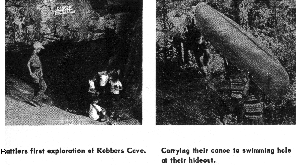

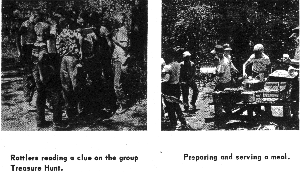

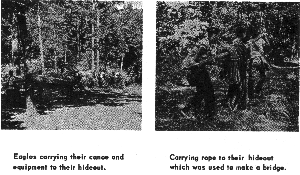
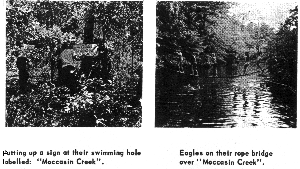
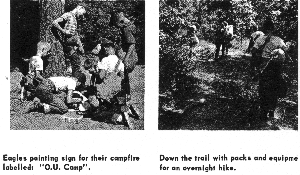
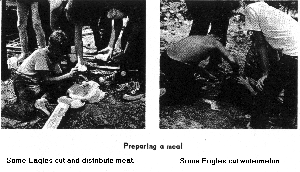
Eagle Group
Representative Activities During In-Group Formation
Stage 1
[p. 80] was allowed. At campfire, Myers built the fire, then disagreed with others on the proper method of roasting marshmellows. Craig stopped the argument, saying: "You're not the boss."
Mason asked if they could take down a sign left by earlier campers. One boy proposed "O. U.
Camp" as a name for the spot, but no decision was reached until the next day, when Myers suggested putting up an O. U. Camp sign as something already "decided."
On Day 2, Clark was last to wake and therefore couldn't play reveille on the bugle. Later in the week, it became standard procedure for the first boy up to awaken Clark, who then woke the rest with the bugle. The boys asked to take the canoe placed near their cabin on a hike downstream after breakfast. Division of labor was complete: 5 boys carrying the canoe, 5
others supplies (including lengths of heavy rope), and one the board and paint for the 0. U.
Camp sign (See Figures). When Davis stopped carrying the canoe, Craig called him into line.
As they prepared to swim at the hideout area, Bryan suggested a bridge across the stream.
After the boys took the initiative along these lines, they were told by staff they could use the rope for this purpose. During swimming Craig took over the canoe, letting one, then another paddle and hitting boys who hung on the back. Mason wanted to get in the water to pull a big rope across for a bridge. All volunteered to help, and this was done through great effort by boys and staff.
In the afternoon when they returned to the hideout for a swim and supper, the rope bridge was completed, as agreed, through Mason's initiative. Craig walked the bridge about 15 feet before falling in, Mason less, and Myers about the same. When Cutler tried, someone said, "He won't make it very far", and there was amazement when he crossed it. The prediction that Cutler could not do as well as Craig and the others reveals the development of differential expectations in line with emerging status relationships within the group. The astonishment at Cutler's success indicates that some standardization of these expectations had already taken place on the second day.
When the boys were hungry, Myers ferried them to the opposite bank, making so many unpleasant comments to the boys that later he heard them discussing him negatively. As a result, Myers made active efforts to be agreeable the next day.
[p. 81] A large copperhead snake was seen 8 feet away from the campsite. After the staff threw at it, the boys were permitted to help kill it. They discussed snakes at length during food preparation. All but one of the boys took over jobs in preparing the meal. After supper a snake was seen in the water, and several boys said they didn't want to swim there again. The boys dubbed this place "Moccasin Creek" that night. In spite of the discussion, they returned to the spot the next morning.
Because the Eagles had 3 possible swimming spots, discussions arose repeatedly during the next few











